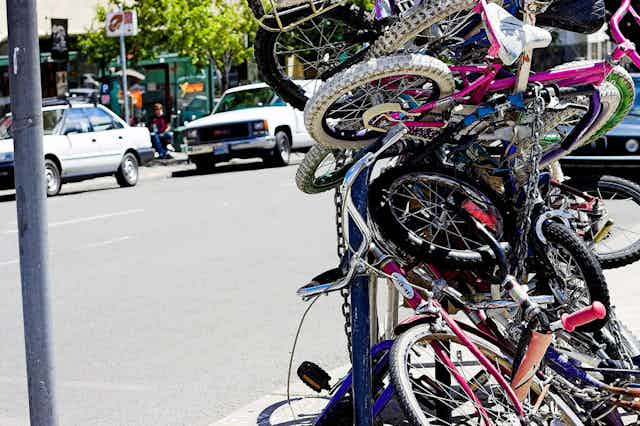Cycling industry reports of significant bicycles sales in Australia suggest a growth in cycling participation. As the Tour de France re-excites interest in cycling around the world, a new analysis published in World Transport Policy and Practice, taking into account population growth, casts doubt that there is a boom in cycling in Australia.
Net decline in cycling
The Australian population grew by 58% between 1986 and 2006 and the daily average number of bicycle trips grew by only 21%, representing a net decline in cycling.
Two national surveys of cycling in Australia were examined. The earlier survey was The Day to Day Travel in Australia 1985-86 (CR69) survey, which examined travel modes among Australians aged nine years and above. The 1985/86 survey results are the earliest known detailed national count of bicycle use. The CR69 survey was a geographically stratified, random sample of households throughout Australia. For a randomly chosen day in the year-long survey period, details of all trips made by all members of the selected household were collected by a self-completed, mail questionnaire. It was conducted by data analysts INSTAT Australia Pty Ltd for the Australian Federal Office of Road Safety and produced a final dataset of 145,000 trips by 45,000 people from 18,000 households.
Data for 2011 are from the 2011 Australian Cycling Participation survey which was conducted in March and April 2011 and is the official baseline data source for the Australian Government’s National Cycling Strategy 2011-2016. The 2011 survey was by telephone and contains details of trips by 24,858 people of all ages from 9,661 households across Australia. The average daily trips by bicycle was estimated, to compare with the earlier national survey.
Total population levels for Australia and for each state and territory from the Australian Bureau of Statistics population Census data for the years 1986 and 2006 were examined.
The Australian population aged nine years and over grew by 58.4% between 1986 and 2006 and the daily average number of bicycle trips grew by only 20.9%, representing a net decline in cycling. These results are conservative. The data from 1985 were standardized to the smaller census population of 1981, and the 2011 survey reported the highest levels of participation in any Australian survey of cycling participation.
Other data support the conclusion that there is no national increase in cycling participation. The proportion of Australian workers riding a bicycle to work from 1986 to 2006 (measured every five years in the Census) has been largely unchanged at about 1% of journeys.
It is important to note that there has been an increase in the absolute number of Australians cycling. Observations of more people cycling and increases in the number of bicycles sold are correct. The need for more bicycle lanes and paths is still a priority to cater for the increased number of people cycling. However, compared to 1985/86, if there was the same rate of bicycle trips as in 1985/86, there would be between a half a million to a million more people cycling today.
Three explanations

There are three likely explanations for the per capita decline in cycling in Australia. These are the historical prioritization of the motor vehicle in urban planning, lack of investment in cycling infrastructure, and mandatory helmet legislation.
The Australian urban sprawl and the desire for the quarter acre block for housing has led to low-density housing and longer distances to destinations of interest, making bicycle use less competitive in transport mode choice. Coupled with little investment in bicycle paths or lanes, most of Australia has not developed a bicycle-friendly environment.
The one cycling specific policy to make cycling safer was mandatory helmet legislation, unique to Australia and New Zealand. This had the unfortunate side effect of reducing the number of Australians cycling by about 30-40%, and even more in New Zealand. Helmet legislation continues to be a barrier to cycling participation, with 23% of Sydney adults reporting they would cycle more if they didn’t have to wear a helmet.
While there has been an increase in the absolute number of people cycling since 1985, and there are local examples of high levels of cycling (e.g., the City of Sydney), across the country there should be many more Australians cycling if we simply maintained the same rate of cycling. Much more needs to be done before claims of a cycling boom can be supported.
People who do not see themselves as “cyclists” might consider riding if there were bike paths or lanes, or if traffic was slowed (to a 30km/h speed limit) in high-demand areas. Substantially more money needs to be spent on bike paths in urban areas to get non-riders cycling. Relaxing helmet laws might also contribute to normalising cycling.
Comments welcome below.

